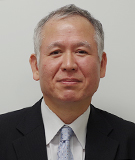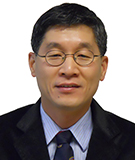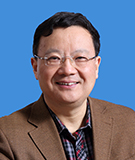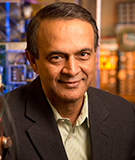Plenary Speakers
A Promising Application of SiC-MOSFET Modules to Bidirectional Isolated DC-DC Converters
9:30-10:05Monday, May 21, 2018

Prof. Hirofumi Akagi
Tokyo Institute of Technology
Hirofumi Akagi received the Ph. D. degree in electrical engineering from Tokyo Institute of Technology, Tokyo, Japan, in March 1979. Since January 2000, he has been Professor, currently Distinguished Professor, in the department of electrical and electronic engineering at Tokyo Institute of Technology. Prior to it, he was Professor at Okayama University, Okayama, Japan, from August 1991 to December 1999, and Assistant and then Associate Professor at Nagaoka University of Technology, Nagaoka, Japan from April 1979 to July 1991.
His research interests include power conversion systems and their applications to industry, transportation, and utility. He has authored and coauthored more than 130 IEEE Transactions papers, and three invited papers in Proceedings of the IEEE.
Dr. Akagi was elevated to the grade of IEEE Fellow in 1996 and the grade of IEEJ Fellow in 2013. He has received six IEEE Transactions Prize Paper Awards. In addition, he is the recipient of the 2001 IEEE Power Electronics Society William E. Newell Award, the 2004 IEEE Industry Applications Society Outstanding Achievement Award, the 2008 IEEE Richard H. Kaufmann Technical Field Award, the 2012 IEEE Power & Energy Society Nari Hingorani Custom Power Award, and the 2018 IEEE Medal in Power Engineering.
Dr. Akagi served as the President of the IEEE Power Electronics Society from 2007 to 2008 for two years, and the IEEE Division II Director from 2015 to 2016 for two years.
Abstract:
Recently, a significant progress has been made in the research and development of SiC (Silicon Carbide) power devices as a result of continuous efforts by research scientists and engineers in academia and industry. This progress has enabled to fabricate not only discrete SiC-SBDs (Schottky barrier diodes), SiC-JFETs and SiC-MOSFETs but also SiC-MOSFET/SBD modules. Conventional 1.2-kV Silicon-IGBT/PND modules can be replaced with emerging 1.2-kV SiC-MOSFET/SBD modules, thus leading to higher conversion efficiencies and higher switching frequencies. Moreover, the latest commuter trains with a nominal dc catenary voltage of 1.5 kV in Japan have been adopting three-phase PWM inverters using 3.3-kV, 1.5-kA SiC-MOSFET modules for driving their traction motors.
A bidirectional isolated dual-active-bridge (DAB) dc-dc converter is symmetrical in circuit topology when the two voltage-source converters are seen upstream and downstream of a medium-frequency transformer, where the turns ratio of the transformer is unity. The connection of an auxiliary snubber capacitor across each SiC-MOSFET allows the dc-dc converter to achieve zero-voltage switching (ZVS). This makes it possible to construct bidirectional isolated dc-dc converters in a range from a few tens to several hundreds of kilowatts, depending strongly on available power devices and their optimal switching frequencies. However, one of the most important research items for putting them into practical use is to improve conversion efficiency at high-frequency operation.
This talk pays much attention to a promising application of 1.2-kV 400-A SiC-MOSFET dual modules without SBDs to the 750-Vdc, 100-kW, 20-kHz bidirectional isolated dual-active-bridge (DAB) dc-dc converter. The conversion efficiency from the dc-input to the dc-output terminals is accurately measured to be 98.3% at the 100-kW (rated-power) operation, and the maximum conversion efficiency is as high as 99.5% at 25-kW operation, excluding the gate-drive and control-circuit losses from the total power loss. The bidirectional isolated DAB dc-dc converters using SiC-MOSFET modules are so flexible that series and/or parallel connections of their individual input and output terminals make it easy to expand the voltage and current ratings for various applications such as the so-called "solid-state transformer" or "power electronic transformer."
>> page top
The Benefits and Challenges of 800V e-Powertrain System
10:05-10:40Monday, May 21, 2018

Dr. Jun Koo Kang
Power Electronics Lab, L&A Center, LG Electronics
Dr. Jun Koo Kang is a Senior Vice president and director of Power Electronics R&D lab in LG Electronics. He is responsible for leading power electronics and motor technologies for automotive and home appliance, and renewable energy areas. He received B.S, M.S, Ph.D. Degree all in Electrical Engineering from Seoul national university, Korea in 1986,88,99 respectively. He has 30 years of experience in power electronics design, control and applications. He worked as a mechatronics manager for Yaskawa Electric corporation in Japan from 1999 to 2003, and worked as Chief engineer and application manager for Yaskawa America Inc. from 2003 to 2014. He led R&D various ac drive applications including oil and gas, HVAC, and elevator. Prior to joining Yaskawa, he worked for LG industrial systems from 1988 to 1997.
Abstract:
Global electric vehicle sales were up more than 25% in 2017. This fast growing trend of EV market is expected to continue over next decade. Battery nominal voltage is generally less than 400V dc in electric vehicle powertrain. Some hybrid or battery electric vehicles (BEV) have a dc-dc converter to boost dc bus voltage to about 650V which enables the reduction of motor size and improvement of motor-inverter efficiency. As the demand of high power EV increases, high voltage 800V dc bus systems have started getting attention for BEV due to various benefits such as lighter thinner cables, higher power density, higher efficiency, and faster charging capability. Especially the fast charging speed of battery is a decisive aspect to ramp up spread of electric vehicles.
On the other hand, there are many challenges for 800V systems to overcome such as motor and inverter insulation, power module, and other automotive components. The presentation will outline the benefits and challenges of 800V e-powertrain system, and concepts and technologies of motor and inverter design, components, and charger will be introduced.
>> page top
Power Electronics Forward to Energy Internet
11:10-11:45Monday, May 21, 2018

Prof. Zhengming Zhao
Tsinghua University
Dr. Zhengming Zhao received his Ph.D. degree from Tsinghua University of China in 1991 and then worked in the university. From 1994 to 1997, he was a Postdoctoral Fellow in the Ohio State University of USA for two years and worked in the University of California at Irvine of USA as a Visiting Scholar for next one year, and then as a Senior Visiting Scholar and Research Professor successively in University of British Columbia and University of Hong Kong in 1998-1999 respectively. Now he is the Professor in Department of Electrical Engineering, Tsinghua University. He is also Deputy Director of State Key Lab of Power Systems, Vice President of Beijing Power Electronic Society, Chairman of IEEE PELS Beijing Chapter, IEEE Fellow and IET Fellow. His research interests include high power electronics, PV applications, motor drives and wireless power transmission.
Abstract:
With the global energy and environmental crisis increased, the renewable energy has gained a wide application now, which is transformed to electricity for use. This is called as the new generation of electric grid, which means a lot of power electronics converters are used in the modern power grid. Furthermore, the energy internet would be the future of the modern grid based on the distributed network and mainly connects the distributed renewable energy resources. In energy internet, one of the most important equipment is so called electric energy router, which connects different sources and lodes. This presentation firstly introduces the basic concepts of energy router and related power electronics equipment in the energy internet, and further states the challenges and opportunities in power electronics forward to energy internet. All the challenges can be concluded the three: increasing the conversion capability, standardizing the design and analysis, and enhancing the reliability of equipment and system. The three challenges are related to three key technical problems in power electronics, which are transient switching characteristics, transient topology model, and transient pulse sequence. All are related to transient process. In the end, the presentation will discuss how to realize and analyze the transient process, which reconsiders the power electronics, propose a novel transient model for power devices and a novel simulation method, so called discrete state and event-driven simulation method for the power electronic systems with multiple time-scale processes.
>> page top
Developments in VSC-HVDC and UHVDC to Interconnect Energy Markets and Renewables
11:45-12:20Monday, May 21, 2018

Dr. Magnus Callavik
General Manager, ABB Sifang Power System Co. Ltd
Dr. E. Magnus Callavik is the General Manager for ABB Sifang Power Systems Ltd, serving the HVDC market in China since November 2017. He graduated from the Royal Institute of Technology, Stockholm (MSc 1994, PhD 1998), and was a Research Fellow at Stanford Research Institute in California during 1994. He holds an Executive MBA from Stockholm School of Economics (2009) and is a certified project management professional (PMP) since 2008. Magnus was employed at ABB in 1999. He has headed several R&D and laboratory management positions at ABB Corporate Research. From 2010 he has been with Grid Integration business units first heading the HVDC Grids program and since 2012 as vice president and business unit Technology manager covering HVDC, Offshore wind connections, FACTS and Power Semiconductor. He has been R&D manager for HVDC in 2015-2016 and digital lead during 2017.
He has served as board member of “KIC Innoenergy” at the European Institute of Technology and vice president of the board of SEK, the Swedish National Committee for IEC and CENELEC during 2011 to 2016. He was convener for the Technology working group at “Friends of the Supergrid” during 2012-2014. He has co-authored more than 30 papers and conference papers and holds a few patents. He is a member of IEEE and CIGRE.
Abstract:
The transportation of electricity by interconnections between renewable generation in locations with the best wind and solar conditions to locations with high loads is the most economical way to use and balance peak generation. High voltage direct current (HVDC) is the preferred means of transmission due to very low losses and less space requirements compared to traditional high voltage alternating current (HVAC) transmission. The introduction of voltage sourced converter (VSC) for HVDC applications provides use of self-controllable power electronic-powered substations, so called HVDC Light using transistor-based semiconductors. Developments in VSC-HVDC since the introduction two decades ago have created a wide arrange of applications suitable for the grid of the future. These transmission assets provide not only power transfer but also the voltage and frequency support, among other functions, needed to strengthen grids with large amount of rapidly changing renewable and fluctuating energy generation. This plenary speech will cover recent and ongoing delivery projects across all continents, recent developments in HVDC Light performance, advancement in classic so-called line-commutated converter (LCC) ultrahigh voltage direct current (UHVDC) applications, and how these new improvements of HVDC technology can be combined for future applications.
>> page top
Decentralized Control Using Power Electronic Devices – An Enabler for the Future Grid
9:00-9:35Tuesday, May 22, 2018

Prof. Deepak Divan
Director, Center for Distributed Energy Georgia Institute of Technology
Dr. Deepak Divan is Professor, John E Pippin Chair, GRA Eminent Scholar and Director of the Center for Distributed Energy at the Georgia Institute of Technology in Atlanta, GA. His field of research is in the areas of power electronics, power systems, smart grids and distributed control of power systems. He works closely with utilities, industry and is actively involved in research, teaching, entrepreneurship and starting new ventures.
Dr. Divan also serves as Founder and Chief Scientist at Varentec, in Santa Clara, CA, and was President and CTO from 2011-14, leading the company as it developed its suite of innovative distributed real-time grid control technologies. Varentec is funded by leading green-tech Venture Capital firm Khosla Ventures and renowned investor Bill Gates.
Dr. Divan is an elected Member of the US National Academy of Engineering, a Fellow of the IEEE, past President of the IEEE Power Electronics Society, and is a recipient of the IEEE William E Newell Field Medal. He has 40 years of academic and industrial experience, 65 issued and pending patents, and over 400 refereed publications. He has founded or seeded several new ventures including Soft Switching Technologies, Innovolt, Varentec and Smart Wires, which together have raised >$160M in venture funding. He received his B. Tech from IIT Kanpur, and his MS and PhD degrees from the University of Calgary, Canada.
Abstract:
The power infrastructure is poised for dramatic change. Drivers include rapid growth in the deployment of exponential technologies such as solar, wind, storage, EVs and power electronics; improved economic, operational and energy efficiency; and higher grid resiliency under cyber-attacks and natural disasters. Data from the field shows severe limitations with using the traditional top-down centralized control strategy, and an alternate decentralized approach with dynamic control capability is needed.
The ‘future’ grid will involve a full integration of the physical and transactive grids, and will be more dynamic, with bidirectional power flows, and a real-time market that all generators and consumers will be able to participate in. This will translate into unique requirements for autonomous distributed control using power converters distributed around the grid. The presentation will highlight several key issues and possible solutions for addressing them, showing that decentralized dynamic control using power electronics is very feasible and provides a path to a future grid that is more resource-efficient, flexible, resilient and can support higher levels of PV and wind energy penetration.
>> page top
Energy Efficiency of Motor/Drives and Power Converters
9:35-10:10Tuesday, May 22, 2018

Prof. Yen-Shin Lai
National Taipei University of Technology
Yen-Shin Lai received the MS degree from Taiwan Tech., Taipei, Taiwan, and the Ph.D. degree from the University of Bristol, Bristol, England, U.K., both in electronic engineering.
In 1987, he joined the Department of Electrical Engineering, Taipei Tech., where he served as the Chairperson during 2003–2006 and has been a Full Professor since 1999, a Distinguished Professor since 2006, and a Chair Professor since 2013.
Dr. Lai received several national and international awards, including the John Hopkinson Premium for the session 1995-1996 from the Institute of Electrical Engineers (IEE), Technical Committee Prize Paper Award from the IEEE IAS Industrial Drives Committee for 2002, the Outstanding Paper Award, International Conference of Renewable Energy Research and Applications, Nagasaki, Japan, 2012, the Best Paper Award, IEEE PEDS, Kitakyushu, Japan, 2013, and the Best Paper Award, Asian Conference on Energy, Power and Transportation Electrification (ACEPT), Singapore, 2017. He received the Outstanding Research Award, National Science Council, Taiwan, 2013. His research interests include control of power converters, inverters, and motor drives.
Dr. Lai served as the Secretary of IEEE IAS Industrial Drives Committee, 2008-2009, Chapter Chair, IEEE IAS Taipei Chapter, 2009-2010. He served as the Vice Chair (2010-2013) and Chair (2014-2015), IEEE IAS Industrial Drives Committee. He also served as Associate Editor, IEEE Trans. on Industry Applications, 2008-2011.
Currently, he serves as Associate Editor, IEEE Trans. on Industrial Electronics, IEEE Trans. on Industrial Informatics, IEEE Journal of Emerging and Selected Topics in Power Electronics, and IET Electrical Power Applications.
He is the Chair of Electrical Power Engineering Division, Ministry of Science and Technology, Taiwan, and President of Taiwan Power Electronics Association, Taiwan. Dr. Lai is an IEEE Fellow.
Abstract:
The Kyoto Protocol was adopted on December 11, 1997 and entered into force on February 16, 2005. There are currently 192 parties to the Protocol to reduce the greenhouse gas emissions by 5% compared with that in 1992. The aspirational goal of the 2015 Paris United Nations Framework Convention on Climate Change (UNFCC) conference is to limit the global warming to 2°C. There are many ways to achieve this target. Energy efficiency is one of the dominant approaches.
To reduce the GHG emission, this talk will introduce the high energy efficiency ways which can be achieved by power electronics technologies, including motor drives, power devices, topology and switching control. Furthermore, the current developments of new energy and carbon capture in Taiwan will be presented.
>> page top




















